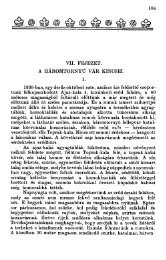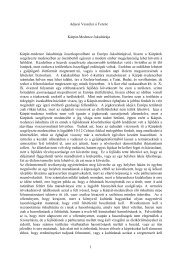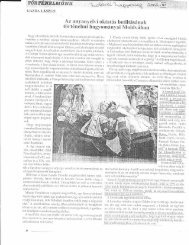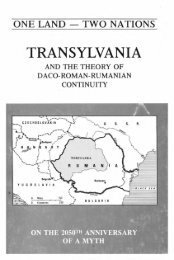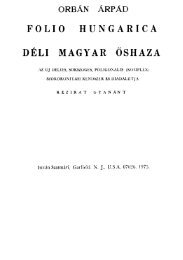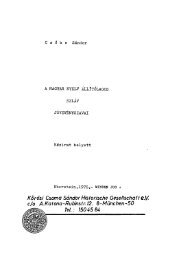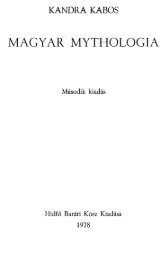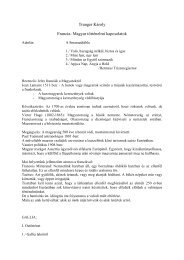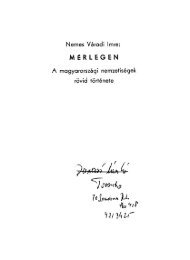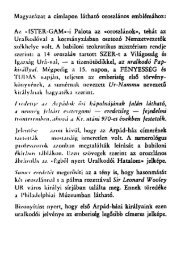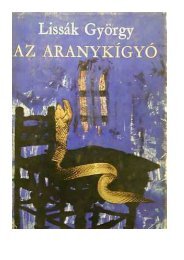Eii":,':"?3#ifi
Eii":,':"?3#ifi
Eii":,':"?3#ifi
Create successful ePaper yourself
Turn your PDF publications into a flip-book with our unique Google optimized e-Paper software.
249<br />
4. MonpEof,oeY<br />
Note: In ord.er to na^ke the infonoation aE exact as.posslble, I frequently<br />
ad duce__original sources, translating the parts tn questi'oa- i;i" -griri"ul if neces_<br />
sary.- I{any of the exanpres on the u side are taken fron Eung"=i.";"b;;;;se it is<br />
best hroun to ne: s,' ad'ded.. reason is that in the si'ple uunlarian ' seniJrrce tne<br />
word. ord.er 18 6tr.u subject - object - preiltcate, urrire, roi-'in;;;;;-;" Finnish<br />
a"lxd Estonian this ls no longer the case.<br />
.41 GENEnAI I'EATURES cf NOMI$A! a.nd. TERIAI CATEGORIES in J and U<br />
flt;] @ so far as it belongs to the genuine J<br />
Eii":,':"?<strong>3#ifi</strong>;; .<br />
since rt has no oa,se flexion, it has to be brought into relatto; wiir trre otr_<br />
er pa"ts of the sentence a) by encli.tlc particles or poetpositlons, b)-iUrough a<br />
sort of inflection of the wo?d.s serying is predlcates, na,nely the ver6s anal the a&<br />
jectives, c) ttrrougtr iuxtaposition. s=;rpi."i - (1" 11,) 4"t"'"" i.'il-iro,u 1r.rr4,<br />
(9. 'na.n', ry gen. /at'tt. narker); o!oa,+ il& & ,"o aee a nan, (a phrase which<br />
ca.n serye a,s a sentence, too; 0J ana cr.r wol Er o is tbe ot; "" i -r-"=iJ" which iq<br />
houever, not the strict equivarent of, srfr-r"tio -[ in ter"a]nr 'eartrri: it is<br />
sooner of - lative/d irectional - sense, sayl -'ioward.s I r-miru i@Gs werr be rra,:rslated<br />
as rthe fact of ".:t1*l) i gtg.rco iri {g+ ,to s:.F-to a-nani o;-;(s;netrrin!)<br />
i?^gt: l_:_? T""t' (g+ is a seneral-EE.-suffi, here servins a aatrve/iaiive func_<br />
}io")i g E E ni rupon/above a nountain r<br />
(to<br />
iv.<br />
b):) _rno.ntainr, ue ,top,<br />
ClJ.yoki_otgkg.'g topsidei)i<br />
sood nan' (trre base-of th;-;;i;.'rts_ waruki' kaze ,iJjii"iru v._.r;<br />
'|a baa wind', (""="-.'1"*')i_ (to c):) ?toko, tatsu i;-nan-t;iuts1ii"""<br />
the noun canraot be sa,id to-E-e tied to' thd veriai i66-t@ r"ri""tioo -or latte?: trr"<br />
@!.9, sini1a"ly_lo gp qd {.T" above, could Le. taten "" " ooorrj r -oioto<br />
g? neshi (ylo later-u 'a nan 6ET-s. rice(Eg is ihe subject narker of post_oJ<br />
tirnesi n. rfood. nad.e of .ricer: thig sentince is reraiii.i; ;;;;i;"j: """'<br />
By wanr of contragt (or comparison), trere . folrow, the "ipi""ir"i6<br />
-s" equivarsxts:<br />
{Flfr, Eql: or rdrri-+dk'@_ '; nan,B'hand, (i.-;a (;;";)-;i;;"iuii,l'*"u_"<br />
'rrr. s'rra;nq_' r ,-9. pxr?dsg; -nek< -ne + -k, latfite /d irectional suffixes ).: rffi_t<br />
+62 .'\he/she/it)<br />
views a nan' ( ttre-suU; e-ct :.s inpiiea, o"" f"oru-it-i;fi;ffi_<br />
text; -! marks the obiect; gli te tne-tare sten- lr1 the furxctidn of D]eed.ica.ro a-,t<br />
sg present indtcative)i f6rE-i-=nek J4r r(sonethine)is eu;J;-i;t;;r-i;#";",-"<br />
above: ..iS;, is the barir sTen;Tfe e;n-6 ai nd, aroieli -lE i-"$i":il ;;E;:"*<br />
cs6.cs-d,-n ron top of a nountain'. (9. . _'noun-ta-ain, , ._L_.Ep"@d-_S<br />
roE._ suff.);<br />
:9 {€rri , t (a) .good .naa' (j! 'gooaiJ the Eu adj. is urrJ.nJ:recrec/i roasz szdl rbad.<br />
1!!:.;-r*"**:l"l"m""igi:'"1::lu j"*:;*'*i;3***i";#=*i;"<br />
ginning with a consona.nt; in earlie? tii&, when Eu useal no deftnite was a den. pron. , neaning ,that<br />
' i _! i6 ob j. narker; i"; gdfki, "=i:."t"r- " -;: ;ii' laoerul.<br />
4-. 1.2 tro clear iiistinction bet$een noninal and verbal og.tcrnnr.i ac __!\,^, +^,r^-ir,"<br />
sound ""t as a surprise ;-;g;: r'n consideration- of fft3";"<br />
the oeten :.ong ptronetlc -sJqu"o""u verb fo::rns. Eoueve?, such or .i<br />
a fo:n as tabenakuie ;rrot<br />
goes back to a<br />
eiting,,<br />
sten tabe nhich ""-,""t'<br />
rr""iig eatenl<br />
in itffi?rn"tiorr.u a noun ( gerund<br />
_44gute<br />
forcn of the piGoeitton is the<br />
-ry$, mLra*enasu "oe""tulith llr"-rrue;iioo._,ffi), o",<br />
'r ao (terns) seen/wat6r.ed-; , rris evoivea r"", ifi" -tr""'6i-;r:iro<br />
""" , ,<br />
first into the fulter sten_ Efu_, then analogicairv r"t" r""e""JJ"i".? :.u r"<br />
rnonosyllabic and disyllabib,er-ba1 fo='s waJd.e category is iot atways Jiear.<br />
. San:gn interestingly contrasts the IE noun c"t"gor? with the ,f irr", -aoa<br />
m€"rks: rrJa,palre€e, eyen in lts noderrf, for:n seens to retiin vestLges or a clna:.tron ""_<br />
1n-whlch,there was inperfect aifferentiation of graonati.car ,--This<br />
"atEgo"i-u. is<br />
quite different at least fron a. relatlvety late Eondition or irr"-in-ii"'go"e""<br />
yhigh t]ave '... fo::nal graonatlcal categ6ries correspon.ing<br />
logical to c"=taf"-plycfro_<br />
categories -- vord-classes such is ,rouns, correspoidinE to the plycholo_<br />
1?f:r""1_"?l:g:lg 'lll"u] I verbs correspond.ins to the psycrr6rogicei !r-on' or cate;oit';;;_<br />
'state,; and<br />
rpropertyr;<br />
adjectivesr. copesponding to the psychoiogical<br />
in Japa.nese, elther ihe psycirologi6al categorX, iu i"riy ""i"gory<br />
"5t -aifr"r_<br />
entiatedr or the correspond.ence between gaa.nma,f,igs1 a,nd. psychologicar categories<br />
-.
250<br />
iE inconplete. Tiie. substantival or noun category_ seens to be the pxina.r one and<br />
io ir"""-["""= "etainedl 14 _sg'.ng cages w]xexe, in 9ttrgr lgreguages.'_ n9w. categories have<br />
d.evelopedrr (P. 7O).<br />
I i';atei- 6r .r aayerlg d19 4opas aq well. E' g: , &. I the present ; the present<br />
tiner can be used. as the eguivalent _of rnowr, in ima na,irimasu rI a,n coning.nowr;<br />
ina no yo I he present o"v'o" tg"' (no gen. /attrSa;ffi; &E rhere; at this<br />
iGcF G histoiically .a noun (in which at least the second -ko psobably nea:rg<br />
ilace', cf. 0J -$, -$i uader entry<br />
'<br />
-Egl-gg)<br />
ft; sien for6; of-adjectives ca.n also firnction ' as nouns' E'c'! @no ngnohiki<br />
rred d.rawers', where al
etc' harde4s frop. freezjjngt,q. Sucb .era.narles bear out schlac?]ter altd _oth_era, for<br />
this sort of fossil evidence nusi be tirousands-of vears oid.<br />
251<br />
- conqiaeriing the ract tpt tF ;ooi rom -;; of<br />
ii"" iT.""i;'-?<br />
noniaal nature,<br />
slnson<br />
e.g.,<br />
writes, is<br />
4 : roi-ti yulcu 'to gor<br />
lg see'., ha+!-ni -;iiorli_vie*irrg,<br />
!vs,ni-+ rto see, viev', Ednir--sttng-ii-ita o.l if 7 a+R..rrar rne so-called rentaikei<br />
(attr. _fornr corresponding to the present par-ticiple 'oi conveniionai;;;ditfeverv<br />
J verb, along uith the. recy6ke+ (or.2nd. base) can firr iH"-i"""tili""i .<br />
norur' one wonders whether the ,l conjugation systen, which tar.es i"l-"iito"gr, i"<br />
a less involved way, the ad.jec,tive. (rJ.iva"i.ii" ""cl ihe ad.j ectt""r-"!=l -<br />
is not . a relatively tate growtl' ri*dfiEEi]ugation sysien"-"i-q."-U i=";.*ue"u.<br />
i[livOaa"rri;,<br />
letts read hou nod.e]Tr Eu linguists inag. ine-the_ one-ti-ue<br />
differentiated.<br />
working of the ueakr-y<br />
word. categod.es rn u/rw. Bl*czi - Benk6<br />
(tr_ansl' - r.iiZ"- iVel<br />
): , ib, ut"t""<br />
" Man5r contesl ttre coevaiiiy oi-irre -aa3 ective<br />
verb. uith the no'n anat<br />
rnrere axe<br />
the<br />
opi.nr.ons accord.ing to whicu the separation of noun a'a was not conplete<br />
ae;ectrve<br />
in the U p-la'guage, and. not even in the I,U p_IanguateJ<br />
Lrords, dependLng in otUer<br />
on the sy_nla9tic situation, a given sten couid.<br />
ad'jective. t"-"iirr6" noun<br />
There i-s no doubt<br />
or<br />
that in today's Eu nost wo"de narked -by-d"Ji:.ty word-class are<br />
or<br />
no'n-ad jectives. 0f the antient noun for:nants,<br />
adiectives ,*y-L"To""a i'<br />
' -too. The syntactic and semantic properties or nu'ravoirrlJti-trr"<br />
beconing ,rou,.u<br />
adjectives and. the adjective€ teco--ing- no'ns. These qual:.tiee'nay rrave<br />
been present to a certain extent in the U and iU p-tanguageu. f__Oo p.-eG,<br />
sane work treats of the<br />
tir"<br />
tu::ring of a nou' or an ad.Sective i.nto an trorc in-<br />
:!T:"; "i""=t. golt"o, rtonorrov' and.!gg3& 'yeaterdayr wexe nouns j.n OEu, but are ad_<br />
I?"ou. (9r tLneJ nouadadrs; vasdrnap rSundayr ca,n function both as a noun<br />
aovero<br />
and as an<br />
(and it seens to have ke4t tts a^nbi.valence<br />
conparative<br />
ever since it was created); the<br />
srad.e of the acrj. _!fu!<br />
,Iate' Ls @gU. i"rri.i, -i"-i";;;,;-;;Jd uor"<br />
:::lyi:: _ "93 : b:]nt ?d3{, _ !!fo! runct ions as-ar ad verb, mea,:ring' raier- on' larry' the ad.j. i sini_<br />
4si. 'lrhich is in front' took on the sigr' of the conparative grade<br />
to becone 94!. -'which is further in front', yet today i.t :." reanlier, aavi=b, ieaning<br />
f o::nerly t .<br />
""<br />
stil1 of interest is Eajd.{.'s description of the anrcr.ent link between noun and<br />
verb (1966r_58, transl.)i ,' .,. we nention here the capacity of trre Sa,noyeA fan_<br />
guages a'nd_ Mg,.dvll? by virtue of uhlch--in preaticative posiiion and witir-out tne<br />
use of verbal suffirces--thes-e la.nguages can- tu:cn the noiinal ("or-, aaj".t:."",<br />
numeral, pronoun) into a vexb, a^nd. oi such occasions the non:iial orirrcrr"ira" l""or"<br />
a verb takee on verbal personal endings and even tine characteriuti"u. rr--u.*.,<br />
MdE prs sg 1<br />
2<br />
5<br />
pI 1<br />
2<br />
1<br />
Past sg 1<br />
2 7,<br />
(non)<br />
Il:t]<br />
tr#l<br />
(<br />
"yri )<br />
od-an<br />
od -at<br />
od.<br />
od.-ta,no<br />
od.-tad.o<br />
od -t<br />
odo-ri-fi<br />
od.o-1i-{<br />
od.o-I<br />
tI an youngl<br />
t You are fr r<br />
rheisnt<br />
tWe- afe rl t<br />
I You are tt I<br />
I they rr tt I<br />
t I was young t<br />
tyou were tt I<br />
rhe WaS tl I<br />
pl- 1 od.o-1i-rlet< twe are ft I<br />
2 od-o-lri-d'e tyou are tr t<br />
3 od.o-I-t' I they. were tt | .<br />
The above paradign i.s instnrctive for several reasons s a) its base j.s the adj.<br />
od- ryoung, newf which. probably belongs under entry gt": t "tg-i;;<br />
t;-+e"g"-;r""ii<br />
yourgest child.'? b) it illustrates how a nominal sten turn;E6 a ve;ffi) we can<br />
obse:rre on it that the Jrd. person aetor can be ind.icated" by the bare s.leni d) ih;<br />
past tense form is created. out of the adj. stem + the verb of existence ufe (+<br />
personal end.ings). Concer:ring u1g, reference j-s mad-e to entry iru,-,o:tr tto b"t ("g<br />
Fi ole-, etc., U *wofg). As Haffi expLains, Md. u1e has becone Fao"&-itr the given<br />
position to a marker of the past tense. I woufd. note that there is some sinilarity<br />
between this fcrnationand.OHu and dial. verb stem + vala (etc.), e.g.; tdtvatZ<br />
'he/sheSaw',j5rvala|he/shewenttoaJId.fro|,1esvaF'h"/.r'",watcilea':F<br />
the ma,ny verb fornations on the J sid.e effected by means of ad.d.ing arifu'to existt
252<br />
which seeos to be a variartt, by spli! r of th" verb of exj-stence i,qtf<br />
shi.rokari 'is rshitet
253<br />
strea^n). He then remarks: ttfn word.s of the t1"pe o, ua.*"rr there is no coales-<br />
cenee , but only iuxtap9 silign, ?nd the r""tting . parts. "orrrrffi<br />
o"f-i-irr;.*r* Jr the two<br />
:hills ?nq s.trea^qsr'--an interegline corollar_T-9f tf,g fact t4it Brr"" j;;";:"<br />
"f e has- no satlsfac-tory gquiviienl of the-gonjunction 'ana i . hlhere semantic<br />
alescenceco-<br />
takqs place it is usually accompanied by phgnetic chans; r'-T;"-r -u*i*"n"<br />
would. mea:l tmountain-streamt.tt--The qule juit quolea d.oes not seen<br />
for a<br />
to<br />
few lines further<br />
be'strict,<br />
d-own sansom<br />
tgrassf<br />
rras tcusauani 'grass and. fl;;;;rl"qilo, icusa<br />
-and ]Igqg..'flowers'1 it is tme, FffiEffi i" given by KenkSrusha<br />
9'"i'ep1ant;.a.f1ower');tKenkyushagives_Effias'treesLnd.p1ants;vegetation' ""*,ffio*-<br />
(kusa tgrasst , ki ttree |<br />
).<br />
EVen if there is some mix-up , paratacti.c composition is clear in a fair number<br />
of casesr and- we are i.nterested..in -such compositions at present. For j.nstance:<br />
0J tunr;sino '' d.ew and frost.r , -k6'<br />
^&-x& 'wif rwife e ana and crriia(=""1r;;-;Hd:";;; child.(ren)', ' mftot-suwe' iri"* s<br />
:?T];F|? !"::), $iri;efai E6?is :bris ?"d and guck',,o;sar.f quckr , wo-sakf ;tffiu,iji'"on1,<br />
, mftot-suwe tstem and.<br />
'tdIGd5eaa ""0<br />
rnight t , pf:rr tdwr)-- v8-pf i.d_. . rrumi-v<br />
? - pi= 'dtllf,Ep,i id. , vumi-va , rbow ,and.<br />
ll-a | ,<br />
-<br />
, matu-kape tpine a4d oakl , pf-tukf<br />
" Jffi"a--"ir " " i rff*"iii n # "5ffi*<br />
?,?+;;?" ;'?, I i d-fi .; ;,l:l:,' i *i: o., I "T; " :; :"' :i;':;I "<br />
f ffi<br />
l" "jl,<br />
'motherarrdfather',|fathera;adffi;r'(titi'father';,,tffi'"o.l"T"yand. iS;,L<br />
house"_S;.sawo' roar and. boating pole','@gpe 'bottom ;ffiE;i, ;;8-;" f color<br />
and. sme1l | , ing-se twife and. husband. | , ipaTffick and. trees r .<br />
Referenceismad.eton6aeiryT5,95ffirrereword.formationinthePI'u/Pu<br />
parent language is treated.. Rdd.ei call-s tcompound. word.sf those which consi.st<br />
two free<br />
of<br />
morphemes, while I d.erivatives I are cal-led. those which contain one free<br />
and- one or more bound. morphemes; the tcompound. word.s t can be split into paratactic<br />
(.^,copulative) hypotactic subgroups;<br />
"ttd<br />
a special branching of the para_<br />
tactic subgroup j-s what ndaei terms the tuniting/copufatj.verone. Members<br />
group of this<br />
express abstract or coLlective concepts iil a manner that they comfrise two<br />
characteristic elements o_f t!" concept in question which elements nly have<br />
opposed- meaninS.g. E.g.e Hu h{r-ndv rrepute, fa4e.t (nir tnews, tid.ing-s, "rrl4 reportr,<br />
n6v 'na,me')/ve E"y'i-piv 'crrildrf[irl ' + ,ioy')/ q" gg=re.'rrunan-#G'-(,wife,<br />
womarr' + '*"Ti ffi"47 z" *i.=-I?*-'visase t racJ, ('n6Gt* 'ro"{rri)7"?*"tjir-r.i=<br />
/.<br />
+*. (+P 'mouthr, +q5' rTose')/ pi maa-ilma rwor1d., .universe, terresirial-<br />
('earthr<br />
airt<br />
land.r + tgkyt)r Est isad.-emad. tparentst (isa-d. tfathersI, ema-d- tnothers'),<br />
suu-E*Iln?d 'face ' (S*t '*ootn@, I eyes, .<br />
R6dei remarks in ttris conttecffiFlTrattll-. ) : nParatactic/copulati.ve compos1tions<br />
form a very archaic common trait of the U languages, and- they issue from an<br />
id-entical attitud.e to maJtfs world.--For the origin of tfriu type of compositi_on<br />
goes back to a tine when abstract and. eollective concepts corrla only bl expressed.<br />
in the way just seen. Such compositions qui.te ]ikely."ii"tea j.n the" pFu/pu parent<br />
language, although we cannot trace any of the now<br />
"*i"ting<br />
copulative compositions<br />
of the member languages back into the era of the parent linguage.tt<br />
When we take a closer l-ook at the J, OJ conpositions of-thfs. (q= approxinate)<br />
tltg_;e.g: r krlsa-ki 'grass("") and. tree(")'; 'vegetation', o= rd-kon 'ili; an4<br />
chi1d.(ren)r; foners fa^nilyt--it is immed.iately apparent that tffitoo, express<br />
abstract and/or collective concepts. It seems th;t this feature of word. formation<br />
in J closely resembles the one on the u sid.e seen just above.<br />
4.2.1 Word. f ornation by d.erivation<br />
4.2.1.1 Derivation from attested. and. assu-med. open monosyl-labic bases.--Reference<br />
is mad.e to Ka 1980 where the possibility of a common pattern of word. d.erivat j.on<br />
in U and. J j.s d.iscussed., with supporting parallels from the A sid.e. Since in the<br />
course of the etymologi.cal analyses we have had. occasion to see numerous stcamples<br />
of the pattern in question, a d.etailed. treatment can be d.ispensed. with here. Iloweverr<br />
two reLevant groups of verbs could. not be presented. en bl-oc, in these<br />
pagesr so they shall be ad.d.uced. now.<br />
EncLo-active versus exo-active 0J verbs:<br />
ka-r-u t borrow t k/.-r-u t wear t ki-y-u t go out/d.ie out I<br />
ka- s-u I Lend- ' ky'- "-o<br />
I to clothe ' td.i-; ' !*titrgui sh r<br />
ke-s-u<br />
tr
d-y-u<br />
td- s-u<br />
*f-"-o<br />
*flml-<br />
"-o<br />
*&-y-o<br />
md- s-u<br />
na-r-u<br />
na- s-u<br />
ni-r-u<br />
ni--s-u<br />
t go beYond- r<br />
' :"3d:<br />
rviewr see<br />
'1et/nake<br />
rviewr see<br />
r (Vi ) burn'<br />
t set afire t<br />
transf er'<br />
rbecome f turn i-nto I<br />
I d-o f achieve I<br />
t resemble I<br />
tmake resemble I<br />
t<br />
see I<br />
I<br />
254<br />
nd-r-u<br />
n&- s-u<br />
(n}toL )po-r-u<br />
(mo\d-)po-s-u<br />
ta-r-u<br />
ta-s-u<br />
vo-r-u<br />
vd- "-"<br />
frirla.<br />
!fuv t<br />
I loaci<br />
bYt<br />
gtt!o<br />
on (".g., a horse)t<br />
' (Vi ) return'<br />
tcause to returnl<br />
rbe ful1/satisfied'<br />
'ad.d.f cogple!e:<br />
tcome nearr<br />
tlet come near; gatherr<br />
I{u verbs derived from roots of (C)V shape:<br />
The case on the J side is cfear, i.e., the root is each time of cv shape, and'<br />
""""L:;;"-;: 3.ti::t"irn?::;s ,. there are a rew which are d ebatable ("' s' ' 4- )'<br />
However, the pattern is plain there, toor and r propose that at least a consj'derabre<br />
part or irr" lexical material in J, the same as in u, can only be explained'<br />
as e j.ther having remained open monosyliabic since time irnmemorial, or as having<br />
derived from such open nono-syllabic roots. The fa,ct that by fa'_ the greater parts<br />
of the respective ,ro"u.bor;;;"";-ig"""1"" J and- genuine u) are known to us in the<br />
-"pp""p"iate1y<br />
rlrnants of verb-nouns, immed'i-<br />
form of d.isyllabic stems ao", falsify the proposition'<br />
9'b9ve<br />
"dt<br />
a.s verb f ormants, or perhaps more<br />
ately following the g"*!""i"';"ca)u""oll* -- nencl afso referred- to as primary expansion<br />
f o"nu,rrI" the J slde seems to have:<br />
-&- ; -Y/-e-; -s- ; -g- ; -g- (and reflexes) ; -I- ; -s-(t") ; -t- ;<br />
-g- t -r:<br />
TheSuggested.correspondencesol1theUsj.dea'Teeitheridenticafinshape<br />
with the above formarrt;";;-aiiiu" f;;; trt"* srightrv gT^gotuiderablv' s' the<br />
tabulation und.er 1.1.1.--A..comp1ete explanatlgi :I th; differences may not be possibfe<br />
for a long tine yet (;h;-9tynoro!i"" *i11 have to be sifted, also new ones<br />
added, etc.)._-At present, a fu]:- of<br />
"tu,ri.u.tion<br />
!h" verb d-erivation patterns can'-<br />
comments and- 4.2'i'7'<br />
not be offeredo but s. t;; p"=iir""t";;;;liosi""r<br />
Reference is made to Sansom<br />
4.2 .5 .2 ng"t"q"i/,:gltq:l*"" -?""t;l*fT3t ;5#;131' ;;"X?;?'i'J'ror."- "pi ' a."n;l<br />
5_*tt1"?; ^ffi"nlii "o*"i<br />
",r)rr,ffi {"g*<br />
ffi"*di#t: ;ffi;{=I}*t:T'=#L<br />
'greatneSS'(:6,ki-shil}arge,great;lls!gry-,suifering'(:kunrshi-shi
In theee exantrlles *.|-ii<br />
ryrl f,or:nations, _g is attached to ad.j. .st9np,..pr1;<br />
ryw- oT s-econdarJr. 3ut !h9 exa.nple kaeru-ga rone is return.r or iqners way of re_<br />
turn'! (! @ rreturarr) show' that it can also be-adiled !o deverbal noiinils, arrd<br />
then the noun so forrnia segnq .to be a rionen actjon:.s.. At qny ""t",<br />
255<br />
-Sr,11"oi t"u,11u_<br />
lates.the clauee. kienr;s? + + q +igen_as 'on ny rbturn i r^'i11'show rre"i-Gn""u<br />
the first nL nust be of loc/adv. of tlnelunction, the second. Ls the particle of<br />
dative/latlve ; $. 'sweetheast' ; Eb! 'tet seei) .<br />
- Other exa,nples: 0J ku-sa ronets coning; when one coroes' (: ku, tater kuru<br />
'coner); truku- sa roners going; lrhen one goes'; Ealca-Ea rinversi6Ti (: sa,lrffiract<br />
?:.1t"?"y. to:, . Sj+sE ropposel.go against'); ry, '""rroess; (trre) ciiiffi aown,<br />
lvJ-; sar-o. oI t-ne heart or of the waves of a body of water).; yoko_Ea rhorizontal<br />
positionri rthe condltion of sonething lying horizontallyi )<br />
0no explains -sa as being cognate-wiih fhe first p"=i 6r .gg@ 'way, nzurnerc,<br />
nealts, conditions; reason'; -€ Eerves to indicate: a) airectl6il b) -(wfren attach_<br />
ed to a verb) condition; tinel-occasion; c) (wben atticheci to aaj. !tJr"-o" no<br />
words of adj. type) nature (of things); quality; d.eg?ee, extent.<br />
Secause we know tha,t a d.enominal noninal fo::nant of shape _E appea?6 in sone<br />
Eu,foxns,\vith correspondences in the cognates (e.g., :1!g ,tows-trin!; nerver, s.<br />
entry ,, the proposition Ls nade that the Eu Roun fo::nant _ 4A1l_ ggg,.-O&u _'ezj!E/<br />
-sz6g is conparable to J, 0J -g.<br />
oe tbe basis of record.s, one. ca"rr distinguish two na,i.n and a few less inportan!<br />
functions of -gful-glE: a) fo::nation of collective nouns, e.g., !.6EgSk- 'populace,<br />
(H. tpeopre r f oIk, nasses t ) , enberi-g6e t na&kind , the human racFTffier 'human<br />
9"t1"')j b). fornarion. of ab;trm;6;out of ad.jectio"u, u.s. ; uu;;=6 ,rJ"iiv,<br />
(ggp rbeautiful, prettyl attractiver), k6srres-sd$ rkind.lines;r (EEEF'tinafy,-<br />
ffi " i'1*#),' :i";3 #ff ;l' ffi "##"' *ff ;il J rl"<br />
" "; 3il1*,m,iHlffi fl '<br />
tive-units,<br />
_e:g: r.$ig rboxder defence area, (ft ra guardr), b6n-sdE rextensive<br />
territory ad.ninistered by a !@r a high royal oti-iciat), o r- ! zdffiezd,g r coun_<br />
try, domainr (8,. _'lord, naetEF) ; a) io::mation or nouni'ei!ffsing-one-connissior5<br />
e.g.r E(H9S rlegateehipr (!!p[ rlegate'), 6rna.ev- sd,S ,high coonantting posl<br />
over gua?d.s' (gn 'guard,, lgg rgTeat, proninent, larger).<br />
Accordlng to D. Sartha (1958, 119-21), the origln of this formant is unrrnol,zr.<br />
sone scholar4s a?e of opinion that it has to do with gfu rhj.rlr, but this eq)lanation<br />
does not sound convincing, --rt is of interest to note that J. Budenz (ilagxrar<br />
Nyelv6r_I, 1e-72,<br />
.148-9) had. p?oposed that the originat neaning of -gi!g,/- sdi ;;y<br />
have had to d.o with ttLme I r since several of the formants of ibstra-ct nofrs itr th.<br />
otlj.er tr'U lupg""q": carl be tTaced back to nouns meaning 'timer. llhLs vou1d. link up<br />
with point b) of the info::nation given by dno in connection with OJ -sa.<br />
Cf. Gulya 1966, 4Tz OsE -g{,/-sa + dual- or plural-narker fulctiins as cotlectIve.<br />
ullf+f, e.g._' jg1-sii-aoo rfather with his son' (d.uat; j9;<br />
idY-se-t ,fathex witir EffiiF(pr).<br />
'father'),<br />
. Cf . SenzinS 1956, 6!: Tg collective suffix *+gt<br />
Itree:), no--sa<br />
".g., 'forest' (gq<br />
*$ tfish, fishesr i l. TQz b ggi3f,irro"i"u'-*g-gao-* ith"-Moogors'/i<br />
p. 7u: -g ta.Tr unkrown eLement) + sa, fore the fornation of nouns expres_<br />
sing nasses consisting of snaLl conponents.<br />
reyesr.<br />
-- Cf. Ransteclt 1957 (f),58: Ma ia_sa<br />
4.2.5.5 Alstract noun fo:med. romed. with _-mi. -mi. --lewin 1?59 1959. , 51 z:<br />
yowa-mi tweakness t (yowashi<br />
'weakJ;El="-rn @<br />
rwhite').'f,ewin [o Fhat the diffe;8fr46<br />
between -sa and -ni is that -sa ind.icates the 'd.egree of<br />
fers to the rseat<br />
a qualit/, while -ni re-<br />
of a qualityr.<br />
Sansom (l9Ze, 294) states in connection with such<br />
( : aka rred.; the red.) that -gi is a suff ix that f orms<br />
val stems.<br />
examples as aka-mi f red.nesst<br />
abstract nouns from ad.jecti-<br />
leavi.ng aside such formati.ons as eirc,shimi t(tfre) suspectingt (r ayashimu tto<br />
suspect t< 3[,qEbi r suspj.cious; marvelous | ; Sansom hj.nself thinks that avashini<br />
is a d.everbal_ '!oun) r we still have the abstract nouns formed. out of adj. stems +<br />
-. I propgse to compare this -ni to Sa^n Yr -*"/-W. (s. f,. Honti | s review concerning<br />
abiiiact nouns in u; NtK-79, 1977, 4j1J fficir Lazar:i'tl,he foin"ation of<br />
abstract nouns in the Uralic languagesrrr Acta Univ. Uppsaliensj.s; Stud.ia Uralica
256<br />
et Altaica 10. A.lmgvist & Wiksell, Uppsala 1975,<br />
*tle"-rg. (^lYf?4:rlg,-'rednessr (i *f,e"- 'red'); cf.<br />
=F-, Y"'/la-@rlet (feYer ) t -<br />
134 pp.).<br />
xnd,:m6'-<br />
Bsamples from SW 1 07:<br />
("- *gitnna- ) 're/uecome<br />
4.2.3.4 ironoun-roTie!i??.--l) { -ry'.ol^-*V-+':. u *:+ ("', tl? treatnent of<br />
the pronorfE-Es-lfETLcal itens under 2.1.12..1 ).--Whetber 0J--45f uhich functions as<br />
p"or,-or- tornent is . id.entical . with the gen./attr. narker -45[ cannot be decideil<br />
at pre sent.<br />
^B) J. oJ -re vs u *-r (s. 2.1.12.1).-- against -E. in oJ glre., ]!4.E., @.E.<br />
'I', fufu. 'yoF (2nO "S), -"d-*. rhe, she, that', ka-re rhe. she'. ta-le rwhor,<br />
omant *-r.<br />
ldu-re rwhichi nhere I we caniE (Lehtisaio 19t6, Tolu pronorninal-f<br />
E.-e. Jty -L i4 rwhati<br />
ry, what,kind' (: g id.)lTe -r in sennr-r. na'na-r<br />
,wtrich, (3 n€n id.r, sr'""-tir:.s,' t[atT),//v;;FwhAEFcr.<br />
fehtisalo l9l3 ""-i-i*r*i;("i.<br />
' tggz FSa,n prononinal fo:sant *-13 ; e.9., h -Jg in se-Ie<br />
.gg;4$,r ge-le-qua rsonebodyt/rn -Le-/-b- in g$1r gEL t such (a)t'<br />
ruho I<br />
4' 2. t' 5 l4.lesiiIg-&=t"ati*<br />
4.2,1.5.1 or,aqi. foln?Tt lsi (.:I:-!+i];:v!;u:l-4or:*-I4'--.Lewin (1-959, 1tT-9)<br />
Doinb out that -Ene rerar,i-ely poor stock of original adjectives in J has been<br />
'supplenented with derivatives by neans of suffixes arrd with subordinative conposiii-"i".<br />
f" the fo1lor,ring, [ewin'-s dtata shall be atlaluced (transf . ): A) tterivatives<br />
wftU -shi (+ final sutiix): a) denoninal fomations' rnostly involving reduplica-<br />
;;;;' ft., otona-shi 'obed'ient, gentlet (ot-ona 'adult personr), katawa-shi rd'efonoed,<br />
crippled.r (kata$a 'defo:mltv'), l}d,"T6ia-urt+ 'eirenaid, e1o;$;;'-1'h"+"<br />
tflower, blossonr); q-shi<br />
rivation from the indefinG/4!4@i forln-of verbs of @.9on;';, e'9" I]@-<br />
EEL rdesirable' (4€ggg, rto d.esire I ) ' .ry+i<br />
rwonanishr (r0e 'wonan')i -b/ deve?Dar rornarLons \q'e-<br />
rdesiTable ' . advlsable ' (ryl]xEl<br />
rwish ror, desire,), isgfa-sr.ri 'ruiy'@-. _ 1o.h*""1 )i ")-t4:?:l?tll: r"'-"-<br />
tio"u (p"ttrv e. g.<br />
=eauiiicat-io-nJ)l , @@!4!i<br />
rvery, irnmeneely'), @l!l: !h! rvhich is not yet (soJ' (ry.'ye'E; no! yer',1'<br />
@;o"i"! i6"ii.<br />
"t+te_ r ercessive i no?e antl norer), @ 'slit-<br />
I ertrene, excessive | (h?'q*a'la<br />
texingr (EiEEtgl.:!9J tglitterLngly: onoE',1 '--l) i<br />
d&iffiith-the surrlx--@- iniervening (+ rinal :Sri*ll ?:e.'<br />
nede-ia-shi 'ausBiciousi happy' (nez[-tuish fori love, adnire')r-s!L]*-i .<br />
ffiy'- G;^"f-41 'sirile')@aqa-sh:L rflat, even, levetr '(hira rflatnegs<br />
--- - - i plainr levelt ) ;<br />
C t- a""i.i"tives iritU the suffix -4g- intervening (+ final sufflx;.sona of the<br />
.t"rJio"i"" i""oived are not clear),-'g. r El1g@<br />
tlittle' soanrtyr (s' entry<br />
ggi""ni) abu-na-shi rdange?ous |<br />
r'lirtyr;.<br />
--Tierffi-tives ' ' .kita-na-F+i,<br />
rsith {he uorii@(-sawaq+i) (+ final suffix), e'9.'<br />
"f.o-EL"-"+i , 'eil1y' . (xgp- 'awkwa,rdleis, clunsiness' ) , 4ilkgi.@L 'lew'I'<br />
llcentious' --- --nj-i""i"if""u (nidari '(trsorcer' ,, t<br />
"ith the suiiix -gEi. (+ fiaal suffix), e'g'; otgko:ra-shi<br />
'nanty, nanfut' (@g '.;*'),-o""";i+'--"ui '1"f".t"' raAliite:-eifEn-iiFe-(g<br />
rwonanr), otona-ra-ehi I ad.ultlike | (g!g 'adult person'.r'<br />
subordinative conpositions: t"-df"*rtt 'fa,noi.s' (E 'ttt^n"'r-tqk?.'high'),<br />
t"-ar*+-"rti inoble'.(i" '"pi=lt')--' !C-YC@!. tsinple' easy to dor (te rhandr'<br />
xgEg- reasy, sxlpre ' ,r.<br />
On the U sidle, three Eources shalt be consulted.-. --A) Lehtisalo-1916 (196 tt.).<br />
* (*r t ?eference to Toivonen [sw i9, 226.ft'J lehtisalo en-<br />
;;";i;"; "#ri"'*]6-""-i-tg tnaT in t ru.ttgrru,ges. it is difficult lo leep apart th9 reflexes of<br />
"oi6<br />
t';6-i;;r-il;"e--oi u *d6; tianir.); rpr tgal€bna-g<br />
".s., rkeen-Eishted' clea.x-<br />
!ieh-t;;* ( #;i;# i<br />
"{" i -<br />
i, bElrli- 8<br />
I or- acute irEa:-Ins{4!!' ear' ) ; M{}1 84.<br />
ioie vear'6ffi6' .(*j.zi 'ftEfi MdE kafta-6 ]!9! 't"rttu' (kafto .rtwor); ch<br />
.d-:U i" ig8q-{a., i!@4. 'ggnile, ;ovia1, polite: snooth' smooth-haire'll<br />
(ve.iaoa-ld ' anoot.rr' ut:-ffi"v?) i-vii i;;:' i"foovr (g rstoner): "1+- f r$iich iB<br />
;;i"frtf iii';""a""n''i't;"tirit *Lid-ii'teneaii'')lqig':g 'ii';rr-(!g. 'nose');<br />
,-blb-ody' 1:tirl^,r,\.<br />
iia-d ria', f .ii 'icei)' btjry-6<br />
^-iji;A<br />
rwhiah i8 behindl<br />
(brjr ,ioon/sDaoe tehj.nd (;; I-aTffin')t ve J@.<br />
iffia'- ("i'. "ir"iiifi'ffi4-ai-1.tiffi""r' '0" 1"r ia.); o" 1!ry 'elenaer' (&. id.)' ign--e! rriSht-hand ei'le'<br />
'
257<br />
(ign 'gootl,,4ei]!tl'); tf *-i.,.<br />
1:g,: in e-u: $Fli .,ra.st' (2!<br />
B) 'background; arse,;<br />
Ay'dTk9..1.934 i. on 1t: fB, the. author points out thet 'ffi /-C (:. _Sl,<br />
,_"", -_irr),<br />
-e (< u i-j$' --..+$ ogcqr' i+ ad.iectj.ves which have<br />
possessoris-f.unction.8.s.,..(.all.r)_"€f;g'yetlowishr(4"8-t;ii;";j,<br />
.either aiil.nutire-'or nonen<br />
feketd-s 'of a br.ack hue slightly urict rTretlte-<br />
' 'btackrJi (nonen possessoris:)<br />
hala:s rabopl4ing in fish' (iE4 'fisfr'), r'iF'watery; iret; rot of<br />
"oot"irrine-a<br />
:"'::i:i,{#?*"?iil:]ie,-ffiu"*"itix; jF,;Y:**m";i'u*:",+"ifp<br />
den' (!!!- r tilt- '|forbid'), igzo,-e 'habitual drinker, (tg"-^,ii: ffu"t"t;j-*-<br />
?sayplo;? r€creud; cr:aningt_ (cs+yar- rtwist, tu::r, y"ydT fra-znao_s ;iy:.rrg, orr_<br />
truthfulr (har"d-, 'to. teIl ri6{f, ry.g,<br />
rknour), tartd-e I durable, stabler (tart- 'tee!]uofa').<br />
,urgergt, (szoioF6Fo"""Liil), --<br />
?f.lo;F 't?icky' (gL_ - 'to trick, dEfifrdr), tuai-g iffi?a, ""rrh"=iy;-jt.,1i_<br />
4'2'J.5.2 J',0{agi-. f?rnant<br />
?Fe/-l,
4. 2.1. 6 Second.ary nor.rn fornation<br />
258<br />
4.2.j.6.1 : i, 0.f (? seegnd.arry) norLn..fqrn?nt -+? (? :aF).vs 9 x--tr! 4e4on. {ormant.<br />
Neithersanthisformation,butinviewof-appg,ren!parallels<br />
I offer what naterial is at ny di-sposal' .<br />
, J ha-ne. *rr+. (o; pu.-re, E) ireatrr" r' , OJ kf-ry: kf . (J ki-ff) lpestle' , 0J<br />
tfto-tt"=, *-St"T;'kiiffiE'-ioi', J ko-.na ^OJ ffi:oil='' ;. ;@' ol-d- nan t<br />
6""=dinffi d""ffi=t ki = oJpnan. fr61e' , & irn;-nEil@e' ; g- seems<br />
to be an endearj.ng prothetie-elenentf OJ s,e;na,-,51g Gpouse t, J su-na,^rg-t ""<br />
tsandy shore, sandt, J wa-na tlassot r! wa tringt (0J id')r 0J wo-F?:na tboyt<br />
(*o rsna1l1 young'; -g, tmale', cf.gl)r_? J, 9J Va;n? rroof t_: E, rhouser"<br />
- Lehtisal-o 1916, 1192 U *-g for the fornation of d.enominal nounsi e.$.e tp<br />
*-na, in orbe-n I sister | , uorpe -ne , giog! id.. /Fi 'gt/-nei in eiihki-pii,<br />
(:-fran fEFT,ila.); esp. rreguently.occurring in animal nanesr-€.8,,-,,W\-na<br />
'anaspene1ope';nstp,ir'rc-nd-i"oii/man-{te,MdM-49'e.g.,.Md-E46e.--@)-<br />
@|3i=rr.t**E-rd-a.rrl:-Eeinwi:na-'height:meaSure:1imitl<br />
thaselnut t<br />
,srand.fatrrerl] irdyi-guiE-G "{e I id. (-@-* in-dim. use), MdE-Fiire. d6.'of<br />
}d tway, pathi ; MdlI -nat cottectj.ve. denom. noun foma,nt, probably -na-+. -!r €.9. I<br />
E-af i eA:l I elm-f orestF(: silli t elm') /2" -wL, d.i-m. r esP. in popular poetry; e. g. I<br />
G,hFghtl)/vs -g, ".s.,E+- ljaw, chin' ("f: o" FT?;l' Vt{ gq ' jaw-bone'<br />
Os -n, €. g. , -fg6"li 'Enall boat r (rdB- 'boat | os -E.r €.$. ) , t6rn3-n. 'little godr.Tglij=g<br />
'small ooar' \x?l'- (e.nd.earingly)<br />
'eud'v' J t<br />
(' 6vu \e'Lr'\rs@r<br />
(tor;;'g6a;1ffix:d-ne'-€.e-,.Jfin'-il..j,''-''o-'s1ed.d.rawnbyreindg-""'(30s.i}tw^<br />
iEA; wood;'coffi"')IpA"e-r{". rterm for close relations anong themselvesr (cf .<br />
Fi pereh tfa.nilyt )/S[ -g, -&; e.-8. , t
259<br />
rsacaed'- staket are werl attested., and the patte& of rrd- Byrr. noun for:nation in J<br />
senerally rese'blea that -oq the U side, r i,irer iirig-c;.rg;;;;9;-il iilTope trrat<br />
nore J, 0J ne,terial wi11 be forthconlne.<br />
tr'or the U side, ref6rbnce_ii _n]le Io RddeL 1975, 95:97. rra,nptes: U *lg1_<br />
lffi -"1ir'P::"'eru:"lii_:ill"it@[llfr ;"1i1;v:,illi-li*-*.J;-*+-"<br />
i:i:""#fri]fl"ffili_ i:fr:,&$t Lffi,;. . *";H";'ru*<br />
'sly, cunnlng t < ? IE Aveetan ioapit tfox; jac*al r).<br />
$;fui;1r16ffff**;n#H f3#Ht+gH;JiEB :;::'ffiT:"i""ffifiu::<br />
tion have deverbar noninal f oms enaing- in -1. n. g. ti"ii"rr"i #hi;i; iur.t ,trr"<br />
blower: the blowing' (fuku 'blow'), ooii 'trrE artikei; the drinktng, (ioifr,to """<br />
"i"r"_<br />
drink i swalrow' ;, rand:ffi+ sr.*ati Fniuata, il;-;jil_;;"il;;?l:hr;#f"o<br />
Ee]:i tthe rrea*ins;mG5t-six-ibata,<br />
jus' or,tr,"<br />
' jar' vase'i uaru 'lo ll"4' ,.ry sel./attx. ;;t";);-i;;hi;;:;{;-,lT"ri7"<br />
"lilsrrir"ii-t=ir.ffiffi<br />
goiTg to yoshino' 1@ ,go'),<br />
!"+4:oJ.i,,rtiii.,uesaenserr (tsur(auEE><br />
viewr).<br />
0n the u sj-d'er one may Fet agai.nst this fo:mation one witir U d.everbal formant<br />
i_-+ (lehtisalo 19i6.. Go rr. ) : E. *: i .ql opstlaja ;;;;;;;; (r"r!1"- ,teach ,);-**" "<br />
l4hgtt6.ie 'sendert (ri*rettii-'u9r,4')/va ffiTthj.ef ' (s"ra-'"f#i'),";G;,'Lli<br />
: ( ?) - livins/dwellingEffiere' (&".<br />
d'ead' (ku13- 'TTiTar"ii_ "or"ffi"' ), kuti''6uring;<br />
'd19'). (th" above'eriffir"s are from p=orri"l)--t6artj.sa1or op. c. 61 r,p(swedfs)- pugllgie,'tburning'_n :<br />
,org<br />
leK.6cge.i who seeks', pdri.i f one who eats';<br />
9aCde '?*".good. at shooting'- (U=adSgtGoot'), *r"To f one [-o.y with sewing,<br />
inhabitant'(asSet'dwe11'),_}ok5e'read-er;(i"a[attffi';;88;'''ii,=ffi*'l,.<br />
@+!l"?I]ll.6TgIq''one.iffi-TJ:1owsg"lik-1.;:@g;ilri"";),'"u""|a',rt<br />
soarro rseamstress'1 p. 6.21 r,ivl-g or :r) k"4+E 'transi""FQa1 (y;i;ear'),<br />
""i+i+ .'forgetful' (unn'forqet' ),Epi.'i:fipffiffi' (98-ii""=" )fti4' ani_<br />
a;tr{.iettito11Y"i,TFi(-d@"'"i};,--('ui"ta"'remember,trrint-o'?i,_<br />
p.aisti 'the roast ' (paistaa 'toEE.t ' ) , . p"igo' ;ffiG6'"tling, *;;";t; ; tbend tbend.;preSsuPon;tornent');cf.E"!(:relj6di'thewaiering;r"",tffi(pairr""<br />
; press upon; toE6F) ; cf . Est (-iffir jddi 'the waterinE: f eastinq.<br />
,to kiss'), 4ifi-;;;; who-<br />
dinner partvt,,(,iSgg, Igive-_to<br />
$rink')''?ti:]86+E"ture; fodd.er; feed.in*i'(sg!ma<br />
rto feed ' )/MdE B?li, MdM p?ta.i.-l$"9i"g_' swal]-ows|(sL1.ens'toswarroilT-ltd.Eefi,-MdME'inhabitant'(efa^ns'd.we11,<br />
@q"<br />
live son"'h6F|ft llv. (..:i) .ttry'_? ry9gl;. t@- 't? prooeh'))ffi( .i)-"ii"i<br />
lli"T'/r* (-g) _th"fi- 'irri"-i'-lF. yr tdrt6 'io--#""ri),-;;il. 'living, (cf . Tilelein<br />
I come to life again t ) .<br />
4.2.r.7 Yerb fo::mation a^nd verb for:na.nts (s. also 4.Z.l.l)<br />
4.2.5.7.1 J, 0J verb forrn?nt -V:e (t vowet) vs U x_k.. T_kk. __trollowing .t ewln<br />
(1959| 129. *"r)-r""-il-d in J:<br />
., a) verbs of,the original vocabulatTr in $hich ,ro -A"=-tvit:.oo rgo' i.".app"="on;<br />
(formerly also rconer), saku rtear, rip, rendr; 0J e;iu rspread ".S.,<br />
i$ltfh thinlyr, SEg 'assist,, !$ ,1"rto"i, ffi .'pi""c";,-!gk"-;"inniyffi=o!,, tu*o<br />
'u"o:Ru*-!?l: .qEE! 'infor:EL toau 'undofi*! ,b1ow;,8., " '' ---'-<br />
, ^" ^:j, i"",:i1i.t__":T?u in -El.: e.g.,_Ea-fu.'(vi) snoll, give<br />
'aqo*r'l, off a scent' (p<br />
Ear?-gu r carry on the ehoulder r (kata rshould.err), gata_nr , strad le,<br />
strlde overr . (ryta t_crotch., fork(ing)), ts;Fru rfasten, 6ina'i-lE;;na ,rope,)i<br />
c ) denoninal ve_rbs -<br />
with the . suff ix conbi;;TIon -ne-ku (ror _nfi'. vert<br />
l.ornSr-rt -9Jr_e.8,, haru-ne-ku rbecome spring-like, foot l-flie spr-irrgi, iro_ne_ku<br />
'De tr-nged riven up' be-stirredr<br />
'<br />
(E -'colour'; s. eatrJr iro where roiTlfiTora<br />
the basic.neaaing rbloodlr is suggested'), ina-ne-ku rbe ii6-e. tyr (4 'tUe p"""""t)<br />
( sound.lnitatLng verbs: ) sg,sa-ne-Eu<br />
. ' to'*hi-5i6FT@ ,uhiip-ering s-or-a;), Ui"fril<br />
p:EE rto cla.nourr (ai$; ;;""4- wi.trrE:tting),<br />
= "seociated - o-r"lko ,to groan,<br />
(g' a sound of groanirig);<br />
d) d.enonlnal verbs with the guffix conbination -v"-go 1"fuo -ra-ror -ya-ku),
260<br />
fi i i; ; ffi: : ";:$;," ?ffi f (: " *:#Tl :1;, { ruffi ' ) i "ffi=,;: ;;i?:<br />
(jgg- , tanra-'G-"k, pGt'jr -",*i-v"-r.. tbe in ;ffi' ("-*i-r-S -'qtr.iek-r).<br />
Accord.iag to iefrtis"io (li:fi, 155.ff .),. gn the U side one frnds -verb-.fsr!qatj-ons<br />
with t[ree suffixes of shape *-E<br />
----'A)'Ugric-Sa,noyed. (*-+k)<br />
suffix x-k for d.everbal- verbs of momenta:<br />
ne.ous/inchoative,<br />
nature; e.g.r Os -ry-- in kd.rtclt frise_, g'et^gPr (kjA- id.), k6t3-v tbe left behind<br />
, ="ru.ir,? i'i4d-"a al\ ffi--,b il" the-sufrix dffui"aii5" E@. ,^ e'8' ,<br />
;'ajJl_rr":r:Ig )ff"gr" to'iich' (fF+ra f to itch')-; x-ka in inchoative formations<br />
( actual suff ix combi.nations r -h$il-ha'l\6', -,'fuI-'E€- ) ' e ' $' , 6fima-ha-1-t6<br />
)(vii";";;;;:(sumad)/sy -k"-1T-t+-t-T*td.variants) in momenta;reous verbs,<br />
e. g. , rran-E$-nnau I to plait r weave ' (p@B rcr' / i<br />
B) u *-a6aeverbal- .rr"=dFG.,<br />
.frequ. .zr ki!-ka-]- l*:"g:.,lYt):{It" EE-<br />
dtr-f -enti<br />
ka_ ,to tug, tear, pruck'/vg + (or variants) ttt@T-?T 'to walkl (.tpti rto.<br />
.<br />
ft"n , il iiii-r-i, 16nt-r6nti T(vr ) swins, *r"y' (G;tiid- ; 'shak".'<br />
) (<br />
r to buzz, boom, ring, siTgfiti-<br />
"oa "r. ; to cractcte, rattle, creak t ) , is
261<br />
:l:';;^T#p1:::_^t:s *-F*i: lg:*,.'^h:1:, .set h?1",:_l (=pire. ,hor_e i), rprv b6srsr_<br />
e _'P9"9te sharpel, b" gharpe+;d' (b6stet' uPstgl 'Jnr<br />
I sharp' )iya vaiao-no-'bright-"rrr-6ffi'"<br />
bright' @. 'brigh! ,),. 1Z Ch<br />
nii tl^^^^*- ..^ - -r t -<br />
4,2.,7.7,., J,,0J lerb f_o:na,+! -n (+ vowel) vs U *-n.--J, OJ vexbs with the foroa.nt<br />
-q \nor counti.ng lts conbinations lrith othes forualltE) are not very numerous. only<br />
$ 'to die' 3.r.rd ilg.'to go,awl:rt.ca.n be catled. as sonehow be:,oirgi;g-io tt"<br />
Exanpres s 0J kasa-nu 'to heap/piIe up; repeatr, r r""="1""* Iaa (@-* aea!, i<br />
!1r"'), o,r faEilu but togeifier'.(t;L ;t;i;,;<br />
9I: J @ ,put in;";;;ii,-<br />
0J pusa-nu I ou.nmarJ.ze, synthes5.ze | IW. '? bunchr), o.@ uooai", ti",,<br />
"io<br />
Largest conjugation category (,y?$e'l:); the xest belong to the shino-nidan calegor5r.<br />
J taba-ne-ru id. ftaba '? p"l+r", a-IG-ch'), o.r t"iu-l"r@r_r,[;irrqoj."",<br />
::E:-?q-1'o""@ 9r.g4fu!, .r t;e;-fi ;i"'..., ro.r.row up, puxsue,, s. entrxr<br />
.gl@/I U,J trrka-nu. J tsulca-ne-ru rto br:ndlat- O.t u'da-n'r .r ihrd--n---, r^-+*.i]|<br />
In conbinatj_on with other formants: a) with _.!5 e.B.,@_""_"";;@EE;<br />
!azu.-ne-r-u,. ++l!e4l4t IIIdA:4e-ru. etc. .<br />
" . Di "tJ! oJ -S, J -- , .e.e. (Miller 1971, 266), gbe-na-tr\r rconply, subnitl<br />
1'g@ I rea11y, - indeed 'rl, afc+:na;Fu 'caxry on traAe i /81%-nn, '.ce r' tiad,e, J , !za_<br />
&. f invite I r ur3-na-Ih ^rto dlivine, tel1 the auspiG-' fg I otacLe,J, udu_na-trb.<br />
treat with, esleem/caret<br />
_f<br />
@, '. thing pertainin6 to nobi1ffi; sonethi'ng ;""fiii" rt<br />
Pui-.-ori{}. rto_loaer (B rbecone Lost, tlisappear, vanrishr); iurther exa.iples fron<br />
Lewln-t>)>r -'tru: lono-na-fir 'acconpaIly r (tono rfxienat, conpanion'), ni_na_fu rto<br />
carxy' (gi, ra burden, a load.'), i suni-na-Eu-.p-lf sh' (@i<br />
J 'offeirce, crTn-); cf.<br />
soko-na:u, 0J qokg-n?-p}<br />
'breal
262<br />
of verb forns I exa.nples tbat na6r be cited includ'e -&@+ :Pl?nr' -ggts+ rconi"o"i;,<br />
X@I 'call',.E@P._'spea,k' sav' tell" rliver.dwe1lr:<br />
ryfq<br />
md @<br />
Frr tbecone aooustomed !q':.All tbese are complex fo:ms tbat show tbis enlargenent<br />
w.i-tn -f'- when con a.i deied- +longsiiie their correspondiig sinplex f orns r na.nely<br />
F.k"""; g4, igEE' k?tar.u, S., ?ld naTE, (Na,kada 1)6Jz )8o) 'tt .<br />
t--9 59-, 110: de-rivatFe suffix-:f$ (intensifying firnction), e'g' ,<br />
rserve | ( sa- intensifying<br />
tataka-fu 'io iigtrt '<br />
-l,"wirr<br />
({;!eSu 'hit., beat ' ) , .S-fu<br />
proolitic; g ,to Sa{d'), n.a*ek=a-fu 'wa '. (lg@. 'con!Iai;T), g!q& 'sing'<br />
1".!g '"o"g;--ho"t po-nt), E:g--rbecone beautifulr {i4 '"oro"' conplexion of<br />
the facer ), saka-fu |n€Le a boundalv' (.W. 'a srope',,.<br />
Coffiiaei-T9Tdl 2?0: U 4everbative *g in fi keff-va present participle forn of<br />
' -t<br />
i:narta:va, [l6ti cent. zJ<br />
Sf,- tgo, *11Lr', cf . kiiY-pe ra,ba t current noneytl svi5-vEi' present participle of<br />
syd- r eat t , cf . xii:!!i ' 6;""" ':ltrrai-"rti"r, ""ie ";6U<br />
-r.,-""t"-p", pres-nt participre oi.Egg!g--.lJo r-;it: !?*'l 9}!iIi1\):t"i:gi !n:::"il<br />
'iirr" r participle of elA- ) ,' alive '@p{4, Liv .i e+aa' -t ) /ve ludqlp ne?. ' ?<br />
tlivel<br />
weeping womarr'Gtdd- 'weepr cry')r sqrlke=e tm91t3r'-(cl' 0s ?"ntf- rbeatr)' +<br />
' d.eacL ' (hool: .' d-ie ' ) , nin-pEl 'going' (Big-, 'go : I 192 iv+ts-w' lltlo,? 'nee(<br />
( ju.tt- G"w') /t Ona';56-- ne who wail-s/goes| (&"- 'go, walk')//Yr @oo-pa<br />
\Srriir<br />
rvj-gorous r<br />
--- (p-g!o- tto be Tear to the end.r- come ne;r be ne.ar to<br />
""coveiTnS-)ffn<br />
kaa-be 'a""ai-@g- ,d ie ' )/st kuu-lie (5131- 1d"?t' 'd1" ',)ly EE-!g. 'd ead r . --Cf .<br />
Ffihffi' 1915/11)Ro; tehtisato@Tz4t ff .; Szinnyei 1922. 77-8.<br />
4.2.1.7., "r, O.r verb forn?+t:T (+ voYel\=vs 9 T:!r 1-E'--Reference j's made to<br />
I,ewin1959,teaoutthatinJ'pasSiveand.meil.io.passive<br />
are fornatty and senanti.cally very close to each other; howeverr in a passive<br />
construction the agent is usually expr;ssed. (and marked- by $}.l e-'8'r. seiio IITFshini<br />
shikara:rr'the fupil is scold.ed bt the teacher' [9. fpupil', E:-'teacher'J),<br />
but in a med.io-p""sive construction there is no expressed- agent; the subject is<br />
passively involved. in some way in a process or stater rro matter whether intention-<br />
-rffy or lrnintentionally. Exa,nples in which the ver! formant,r is involved-: hibashi<br />
hai-ni sasaru 'the rire ilffi;-(;"G.)';;;;,;;i"e-pi"""a il t-h'e ashes/a^nbersT@<br />
@r,'i'ashes',SaSu.'stickfputfplaceinto'),on9ti*era.r9n}.'remember,<br />
""i-i"i";;;" (;rF'think oi rflearr"' , id'eru -'Lome got, emerge | ) , inochi d-ake wa tasuka:rr<br />
'set'ffiof difficulties witrtaFs bare lifel (g: lil,l:l:^*;.ronlv'r }E<br />
topic marker, tasukenr t to help | , @uEagq rbe savedf rescued-/helped- t ) r mukashi'-no<br />
koto-sa shinobareru trecall events-ffi-past t (g. rold- ti-mes, the past t r no<br />
|word-;matter,thing,happening:1gsubjectmarker'<br />
itrinotu '="r"rt"=i ;l@t" that in the f orms shil,
263<br />
*:2:1:!.6 0:I.veTb-fgT+ant.-v (+ vower) vs u x-;1.--sa,nso.m (lgze, 1j9) states<br />
that the earliest J lj-terature enployed. for the passive/ned.io passive almost exclusively_<br />
-Xg *td (:.ts combination with another lorrnant) -ra-vu (-g1 was attached.<br />
to verbs whose imperfect base end.ed. in -&e whil_e -ra-tru tAnT with verbs whose<br />
imperfect base end-ed. in -i o" -g). --Lewj.n (T959, 15O), f-*"ver, treats only of 0J<br />
passive formants -ru and_-El ("11 later forms). It would. segm that:re-tfu simpfy<br />
contained both sho?f, passive duffixes (cf . -trt6 u" cags. suf_f . combinEffiffi -i-t--<br />
i-n szaka-.i.-t: l!eai, plucf-r vs siaka-a- tbecome torn; , szalsu-r- tbecome squffied. t ,<br />
or---- 6:t-e-t:-?to-feed., cause to eatt vs OIru fu[- id..).--Exa"np1e.s froil Sansom:<br />
hj-to ni shj-ra-I,nr na tlet it not be known to ment (b. tpeoplel personrn ni is a
aeneral 1oc. particlg Uhich also.seees tQ be useful in--passive go4struqtiong;<br />
264<br />
ihiru ,to knovr; na, p".uiilitii"/""e"ti.i; p""iior";, rnilg ni shira:Yg:+$ -u'nailito<br />
fffg=oor not anown-ny gighti (niru tseer; nu is a privativg/4e9.: Pa;r'trgae; una<br />
'f,oi""i 1;--.qxa,nnGs 'fron-lewiriTgt. -150: .-itoui-vg rbe.haleQ'r , ,<br />
k"i:?Pt:.-Et rbe re-<br />
*:li;:i::*iffi ;:il::ti;=eii-ll:E;-+j#"Ji"!i:tff-i'"J*""-<br />
jlri"i"i"a;, E. 'be, sbot; (cf . 'ib--;-hoo1r (with bow an'1 arrow)), 41@ rbe af1a.rae,.bu-nt<br />
(sr'.@, 'sei ari$T'), $!1gl.'go out' die (1s a fta'ne or fire)'-<br />
(cr. ki!-tu,.,ke-su 'extine;isn;jl-(t1',i;l!]4o-sproui, u"ii)' igrgr tbe cutr (cf'<br />
e,Fr::ill,E#_:*"*i",:l;*T$:;i3l";,"#;":;"il=:il*i,,"7pe*_,i.,u<br />
verbs.--!pN -i.g- in ="t (-giga),-t'e' ' i."tt,"l rbe co-l ted/r. -ead '. (9f.' loEkat<br />
Icount, read|), @gti}!'rE;-broken,/snashed't"r.-og4j?t_'break'(ihr;;GE)T?<br />
sorr-ut rset sewnt ("1. soa"rot i""i) ;--r'ps*"li' -gil- t e'g'I B!l+ig:<br />
ffi _,#,tinilxs$;;Hff ?'ru""*3:":;?irls__-'q!,oi"'lili*r*"-<br />
,seu,). kuet-ie- rbe forglvenr (tcttte- 'leavei pldoii 6;6f"-", iernit'), :i$-t-'i "-<br />
'i"'i"i!";tfffalnt": lio-"ot"" d6iieat')/osr -ig in.tle entu'ns -+.' e's.'<br />
ffi ,il#il*iif iH#ili:;*+j#-:i#.r"-11*+ffi ".<br />
Fr was overcone./beaten'! (e;*"tg--_1-o-1"o1"_l?')/il7r:;g"_i,;r;t",;$;Zrffi<br />
'i cut nyself'/tn *-;t- a -e- (ref1..) in n?t-e;l<br />
sk *-ia- / -Na- in the conbi! ation -yg'1-.p-ta-- 1r-rE-frf,' e'81 ' !l:j-4 'loose<br />
ii"'""fi"!.,:g"t-io;;; (;i. -urtipEa'n Eo-rosE-',.,@9, rto rorset')r +q-ie=l or<br />
;;-;-lil ?e"t-"".t",i ; "rffi 6it4-ial )iEgl"-'; itf -e-{a-rn' suspend'''<br />
4.2.1.7.7 0J verb fo::rnant -t (+ vo{e1).vs-U 1-!' --Tlxe treatnent of tbis 0J vexb<br />
fo::nant seens to have been neglecteil. standald W6rks are sj-1ent about it (sinl1ar-<br />
iJ"i.'irr"-i"qe of the oJ-c"""iii"" fo::roan! -!.;1 to follow next). --trka.nples frolo<br />
onodaka s"'d ono : ira-tu 1|i-'1"-i""it"t"a/"eEti'ea' ^(ig, I iT=ll :l:-{,*3:a-aa!sY<br />
;i"-ii"rt"i"il "1ffwirJr3 -datsu probaliy cones ri6t-tatsu tto stand ' ) ' Doni-tu<br />
>,41g t(tree -teaves,l-iJ"oiF"aii"rt/r."ir9'1' (v' ana E'n' rconi': cf ' noei-ta-Du<br />
(y.) ttrees a.nd foxests tal
265<br />
ry,' ]?:i i": .,:"t*i"ate, talre,its gource, issue,fron' (cf.. td+aszt- .'na.ke rise,)<br />
&W. .\v1J aonere/srrck to, (cf. ra"{raszt_ ,(vt) stick, gloe'), bd.rrrra_d_ ,gror,r<br />
Ttiea/-weak/exh?ustea ' (ci. t{esri! zt-E-exrrausi, w9p{erllr daAa-d- rxi-se., swelr'<br />
!"f . 4gggg.!.- 'knead; cause-To-Eli6,) , herva-d- -wittr<br />
'wilt, (_cr. t"*iur{I--<br />
'cause to wiLt, etc.'),, duzza-d-: rswell, riser (e.g,, a_bud or<br />
zaszt-'cause<br />
a<br />
to ris6/sGi1f, enae-a-'yield;'th;;i f"Jia-"r1"""i;'":;l;"ffi; =iverfffior_<br />
ground., or Lce over tb.e waters), ggE-d- rcauge '(Vi) tire, flag, slacken,-(cf. ernveszt_<br />
to tire, etc.r).<br />
Cf. lehtisalo 1915, 2162 ppermian *-_d4 for:ns verbs that have the general<br />
senee of rbecorni.'g tulning.!.nto sonettring-, attqlning a new.state q"<br />
?.s.'.It{.fiea;!t-{--4?t=L-e.-'become "oiaitioo',<br />
sort'.1493ig-'u?lt'), (Aon-fhair<br />
eg"-dZ-j---;i;-rr;,i"y'<br />
on the body')/Zr ia-d.t-*va-Z-i- 'b;;;;; wet,/waijry-@*ater,<br />
Cf . Ra,nstettt ),<br />
19|27 G),, tT-1, ru^F'feet ashaned.', Mo !1g['6e anxious/de_<br />
pressed.r
266<br />
verb, r' or rather :.ts perfective aqpect" (F:,"1F9 I,eYln 195?r.166.-7).'.<br />
Exa^mpre"i 1" ni ug4i irete uchi- ni rnoihite kinu rhe took her in his hand.s<br />
""a t"li-*rri"rr"<br />
oth !-ines; +<br />
^ughj. 1reru,, ind.icates<br />
igl:ickly to ao'-(q. entry g!i-); irgte is the genrnd. 9f igf 'plaee/put<br />
intor ; uchi thouse, home t; g,. I genrnd- of motsu thold.r keep ]; ki- is the ind.efi-<br />
;;; ("f":teverbal- noninar) ioir of ku 'EoE,Ji; ggi-s" + tu(nl) '!=118')., k.o-+o ko<br />
wo rits<br />
tu fafter he had.<br />
bamboos co e' -(Fo;"? 'thisr;<br />
ko 'child. I i wo, ob j ec-t marker; ni:tsuku tcateh si65ht of , f ind-'<br />
i,_ry++ 'af terwarclr ;<br />
E,J-sanety"1-ro*n"!art, i.€., ;g;frt- 'existr) qualifyittst"kF)J!.rrba^mboo';<br />
k. rtfring, event r (attr. form of the verb + koto form an abstract noun) ; kasanaru<br />
?ivii"il:;"J..", grow in size or frequ"""y') 1E-wa Etrrq 'autu-mn has coneT-(l-ti-<br />
'autu:nn'; g, ioii" marker; ki-r &s in the.ri=stffi-o), _noniii-w?. yado-ni<br />
furishikinu r the coloured. leFes in the house are fallen and. spread- themselves t<br />
@"a1eaf|;9ttopicnarter;.y?do|house|;n}'.;1o:.:}f{:;9T?|tofa11l'<br />
shiku ,spreai'.--1r,""fr'1gj.i, lee ) shiffiT
267<br />
|fromtEed.ayw!t9nEEEr-@qconjuncti]veroi'-oi-ff{i"iffioIIJtl[C-<br />
ll""'; !. 'time.'; ai pi-shi functions as a qualifier to toki), kikite-shi hj, ycli<br />
tive form "r !u' ?,{1"?tionarJEiective suffix, ;;;rffi:th- nu; hi lday,; yori<br />
_'fromf , a pos_tposition), +ube Jio. yaqahulci .targ.ka- taori-shi<br />
kerria on the *gg": 'whilpliFfea tfr"<br />
' (+u<br />
' ; la"e iwtro ' r 'li, t.ef-oaative_ particle in-<br />
i laoTi, is the conjuncti.ve foin of a (""=iffi<br />
";;; io=*<br />
which must be related. to tubunr'be cnrshed./battered.t and.'perhaps<br />
ruined'f<br />
to irpo=,r--tu"<br />
cf. clJ taoru t"6I1frT",<br />
!e ruj.ned.'i s. entries taory ,rra<br />
as to the ori-gi.n f,fl@i and :9, _gbr!iff).::<br />
sansom notes, "nii"="-i"ffir;; #id":""" to<br />
show the o"igin of trrffi two silffixes . . . i lot it is j.ntere"tiil*;o=rroil''that the<br />
verb ku::u make s pred.icative f orms with ghi (ui7.<br />
--;;;<br />
kj.- shi and k!-;hil , not with<br />
E' .wffi5 tne ,t"iu suru nakes the pred.iFt:ive ro"r- f. *nir" meaning of ki seems<br />
to inai cate !tt?t it;F have a co"on origin with th-ft:rb toor, and. sfri ailf, ;;;;"<br />
perhaps constitute a simj.lar pairrt- (turu = Fy tcome f , suru
268<br />
in It and A by I. Sinor (s.. sirLor 1911-2, 2o1-3o) '<br />
4.1.1 Case suffixe s,/Particle!<br />
-^-<br />
co'ruiecEf6i-iff,l, the cproparison. of tuq ggJ'-,.<br />
J does not have lne c-ofrFison of the a'ti ' in tbe IE sense' 3ut the?e are<br />
variouscircuI01ocutory""v-"-t"_o""""onethisd.1ff1cu1ty.E.g.,@g<br />
f.i-""i-;ti.l-ff o""" ts-p""iifer' (g Jthatr' 4. tflone?t'.gP<br />
.t931" rnanker' E'<br />
E6E, nrctr nore" E. rprettyt)r.?oo,h*" to.!?.f" kirei 'Fhat flo$er is prettlerl<br />
(no qen. marker ' ho- rside, ilirectiont ' s+.:Y?t":l-ffi)<br />
ra<br />
i-TiP?n;co Y? ei-so vori<br />
tfit'r"iiii'lii-"iii-l"ir'" .r.r"is"'s"-iu than Exsrish' (re. 'ransuase"<br />
ei-eo rthe E. 'oi"-a{li;:}l J-anguage., -gl tiropt, no reven; a1sor. n' I troublesone; difficultrS<br />
ffit"ii:;t"t$iliili*1ffi ill ":siiJ'lT*,?*;.;::<br />
verbal non. of EEI34, i""tp"""', & 't" able-; ca'nt ' m' I thing' natterr<br />
'<br />
g!<br />
;irr""-i" not; w[fln is not'). . ta ---:<br />
ffii ffi .ry:i**,ii-ii:*:i'i': "<br />
oJ and c1J prefesred to use ]ry.!t e.g., . (Lewin 1959, 82) z !&tgl.<br />
,to be superior to other peoPlg' (4''person<br />
".q';"""|"'"":<br />
t6 t6f,t'--t . .- -Ioasarulg<br />
l1o:) sa*ura,voli une -ya<br />
ha{a'ill- S;k; I*-:-t"tly btoons earlier thar the flower-<br />
t<br />
pruaus<br />
quickly |<br />
' saku<br />
ins cherryr ( sa&ura ' t .roi-i"g-"uu="y ' ' 94c.. f ' h' 'earryi<br />
Ito blossonr)r *" *'o"i uli.i"3<br />
"u'-"tit*iu[f<br />
'tire t' ctteiry is lovelier than the<br />
n*t3*r"<br />
(ilia. ) notes that in 0J, yg! had the variants.xg' .$'r and,4lLr e'8'I<br />
ffi ;ffiq*" i,i;;i*;:: :i:"T i;"#ffi i#_., -<br />
i*#*+-+";ffi"-1i*,l::*til:,"ruit";i**"tl;il:i.@-3i;"3fl "<br />
ll'i:";;:h"<br />
'"3"1":; li:'fl1h*""llli");,<br />
;::;"'.rfi ;;:t;;:"U,&l*#fr {:l;;"il,"'*i:H"i',:"il'"-'i=i."i;}i""*"'<br />
direotion' as it were ttouard !?op+e'3 c1'-++r9jr9ri-ryge4t; aite-ni otoru 'to be<br />
t"t"illi"liril"ifl""iln:ti:l'.liiE*"i'tilZti L)++l te'1s us !l*t.',... the sra'naticat<br />
category of conpa?ison is- lacking\in the Uralic languages a'nd in<br />
1il'"f<br />
'<br />
sone of then ( Cherenis, 'Volyt*, Ka'roassian) a suffix of tu?kisb or-igin is use'I'<br />
tr'ennlc, Laplish' and Eungarian have a /xl4g<br />
"o*o" "otiiiailvelureix<br />
+ 'voweV'<br />
but this specific t""""'i3i"ii"o"iliv ["""r"p"a seiarate:-v in the Wesf, and' in the<br />
tt"tiji oao"" words' PII probabry had no othe? way of na'king the oomparison of tbe<br />
adj. than bv circumrocu;;i;::+t:",:.ii^"?T3,oflll :#"'*:::":l*;,t??ii"?o;"'""<br />
?:''.?ir,"i',t.it-'hoo""',j..|good-|,tin'thi.s|,.q.<br />
-<br />
,rrom' ) , (p . ?e ft;+ ;u! i i',4' t.:t+ttT:I: *:H"ti*lit?*13t"f;";:"*?:u;":t"t<br />
,l;l3'l: .!l;"li" 1tt house is *?:*<br />
than that oI<br />
(a. ,big,;<br />
only in comparative.constrrrctions, but it<br />
remai.ns uncrear what its components ;;";;i";; it is not attached' to the adj " '<br />
its fr.mction must be the as that<br />
"*L ?f,---9T):*^<br />
In vg, the comparative is expressed !y3"?1t of the abl-ative case coupled<br />
withthepo"iii,,"brade.,;.;:,--(K4t,1a,,n65,4o)."ffiul"ilT]"i#",<br />
fbetterJ' , Lin-trat-l"t rt"!:"iq& aff"iti'itmgger<br />
:;;:lrFg4,U"#il' ;*l**IllSlt=?d=ri-' $!"'iia i3rre" tr"' *v-r"tr'ui' ffit "<br />
,you(are)fronnyr"tr'"*ffi:;'.+.iiv-,t"t4:":,,i.'ta11r).--Thesuff.<br />
-nel is anarysed as -no (l-oc' ) *=f Tiiimota 1965' 64)'<br />
!{r;ti::{::p"="ii""i<br />
r-inks up with tlie Hg'way or-adJ. comparis-on. T:s.,<br />
a bor a v{?-n61 jobb<br />
,wj.ne -This is better tha' waterr (rit., 'rirrl wate-r-fron uetter" s' def--iilite article;<br />
viz,waterr;-n61 the sarne as vg -EL; iobb
of tl" adi: (nod.ern) jg + the reftex of rTI *-g+ yowel) . .<br />
269<br />
::?::iF;::IH:i.:l*.{lj**ii.;l;fti.:=:;;t'TIil?lzl3i.<br />
suf.fix), rs-tgg-ni,.fc;r,rebE,'highei u.*trnoa,_(r. GEr; tF:?pg_=-fel.igbb), nirrd6nfffi'-"::*:"T-:l?:-"iI|y:,::::,(*;^]"}1;'t":y''.:..'<br />
t sQ?- P, it?llgi lkn,p !oyJ='i-. 'nofsi;;;"#<br />
sz61$s fwide, I 'bigger';h;;<br />
'<br />
"-t'"tTl^*<br />
g4lreD<br />
AsmaybeSeen,thecnr@is--ne-r(ro".+ab1ative/sep.<br />
eeeg, uIt, sluurirr tslrrr1x an vg is _gl (loc, + ablative/separatlve )E<br />
sta.nd.ard Eu uees -n61. the cognate of vg _nJI, wnFaiar. u" """"']"i, iirri, a"_<br />
l?.li?i",:.*:::"j: :9^ #r -4-r,""-a-ai"3"tfr,,=i,r"u.ou", r*e-;towiia,f",,i _torr17<br />
-grg,l (lrhere we note that the latter suffix cluster i6 id enticar. wiirr<br />
Hu<br />
sianoara<br />
-tc!!/-t61) of abtative/separative function.<br />
The questi.on now arises: !'lhat j.s<br />
.the origin of IIu d.ial &u/-tri ? (ffre<br />
-1 comes from suffix<br />
9s"19 1:!' s. Hajd.ri 1966, 12?-t.)--tt<br />
tinuer """*"<br />
tE-"t<br />
of th:.U ablative ,!ryi-jg-;" the con-<br />
suffix x-t + vowel (". further on in connection with 0J<br />
s),-in"-"o"tinuer havj.ns :.uilu;;f ;";:-ii,li;";:;3:: ;:-_l: ;"#::li"luil1ll ot<br />
not near their head-s ]t}"?hi+d.1ies?!-(nextto)ir'"r""i/oitheparents'ffina<br />
| (a a"rinite articte r g,. i chrt-cl r r Ldi 'rooi '; ;*'t €,:t' rii"},,<br />
i:::::^}sI-:to: ":tj;<br />
r?.i 'head._t)r._'l this E-xa,nple, -gr@ is clearly of loc.<br />
runctioillot in kalapE.n?ryolh 'bisger lhan ;."j.r;ionar-*i iil!'i.i',!i"rr"=<br />
thanone'sfist:@';9i+i'|::!v-tiimarks"ffire."pil'ti'".<br />
Sinilarlv in ?- fal--tu hu?d 91 t @rr [itl Li"ya"on-trre wat]-' (fat- 'watt ;i:-' "'<br />
The 0s reflex of Ugric te-l (ablative) is not found. j.n connection with the com-<br />
-(lr"iaA"r ;ee'; i;b;"*<br />
parative, but here follow sonE exampl-es illustrating its<br />
ko-.L^'Eo-1.. twhence, from where t ,. tc-I tfrom herer , 6wi-1i """ rfrom the side of<br />
besid ; from<br />
e I , t5,= l; ( ta,] 'frog here ' (wEEG -ta strengthens -l- which j.s the<br />
questi-on<br />
ref lex in<br />
; although Haj d-rl- d oes not say so , r suggest thaT<br />
separative -ta is also an<br />
suffix, probably cognate with "iiiiiiZ t<br />
Hu di;l . -!il-,,!g):-<br />
Su-nming up, I propose that a) d.ial. Hu -ni ( rsten-nIic;rfS!8, etc.) is comparab1ewith/:'9',-4,i',S&I:trito-ninasail(@ootherp"opt"'),<br />
b]- uelirc *-L. (abiatr-ve/sepa""ii"fr" comparable with the element -ri of oJ<br />
-W,/,-yru-v+t ,c) IIU c-ial-. -tyJ-tii is comparable with the element -y"- /lv;a of OJ<br />
-vo-rL/-vu-ri (for the opposition J, 0.1'f,.1 : Ugri.c *!-, s. entry O.fftic:ficf.<br />
also vari a,nd vue; cf . further Muraya^u Tgj7, 77oi oT irct< *-aui -gf;-d.u-r_i;<br />
p.121i0J-t".maybetakenasthevoice1essvarj.arrtoF-ur=x-d.u),d)oJ@/<br />
-y-uri is a combination of two suffixes and probably has to-To with -tu which j.s<br />
polyfunctj.onal (s. the treatment of<br />
- a ----<br />
-to ).<br />
1.-1.1._? r. 9r tlf'+""try: *t@.__sanson<br />
(j9za, 255) ttsts<br />
ryas a,n adverbi.a-i- parti.cle, ,neaning ras far asi uJotirr, but arso allows it as<br />
a case particre. Eis exa,nples (p. 26))z kod.omo nl nade atieru 'to gi;e even to ttre<br />
chil-dre'r (E. 'child, childrenil n:., 6r a-a ffiffifr.'ii";;i- i'ru naae<br />
si tby the time he coneer (k. tcoi6i, used h""" u," a noun, un-te6s maare itself is<br />
conceived of as a noun, in wbich case kuru is there in an attr. funEion; i.n both<br />
:Ta.nple:, ,naae,^is combined -with ni), hdito niru nacle 'ag far "" -""irrg'tlr", ""<br />
rJ-owers' (+. _'rlover'; e 'asi in the rofe of i g. rseer, probably used as a noun)<br />
lewin, (1!l!' 82). writes of rocat a^r:.d tenporar adverbial f'nctions of roade,<br />
e.9., fy6!o-vg.ri. Oe+k?-nade rfron lgroto as far as 0sakar, otoko Musash.i_n6-kuni_<br />
Iltaoe, madoj.-a,Ij.kj'kerj. 'a nan, trying to find his way, uadrdered about ag far as the.<br />
province Musashi | (9. traot i !. tprovince, countryt; gglg-nayou rlose oners wayr)<br />
yg ,fy.Fugu-mad e asobi-wo-zo ghi-ta,nau-naru tthey a,nusert thenselves late into the<br />
nj.ghtr (p rnightri 4. tget later; a. rpladr, a.nusenentt; gg, acc. narker; zo is a<br />
paxticle of enphasis i -Eli. < g'ao'; !. 'to deignr (:.n polfte styte); n. 'f-6').<br />
IUV 115! Ch..nu6an 'at last'; &E9., ggIE 'alongi through; throughout i the<br />
whole tinet,. nuEno.rat the endr, nada5, gg@f rend., point, topr ,/ Yg no!, maE,<br />
4gg. 'tilrr / 0s p*g, @'as far as, to; titl't-- FU 7'nud3.1-Gulya 1)65, )1 z<br />
osE toro puv3l noded nranlaro rI will go as far as that village' (@ 'that'; g.<br />
'vitI@'l).--g.Intw@.("r.pxobabIeTgeorrespond.ence-s).<br />
4.5.3.1 J -chi, OJ -ti (locative) vs pFU *-t ("-Ile/-tte) . --Examp16s: oJ kd-ti,<br />
J ko-chi-ra there; this way', 0J place:/wary; yout, J so-chj.-ra fyour<br />
"&-ti'that
270<br />
place; you; the otherl, Ol rthefgr- yond'eT;.that; the other" J a-chi-ra id"<br />
?-l+<br />
cf.a-chi--ko-chi]her9u,,,E]Tfi""";r'iir'!"and.,trr:.itrer;toq,4dfio;'ffis/<br />
sporffiJ.rv@'where'?.J'd.o-tchi/d.o-chi-ra|where,whatp1ace|,0J<br />
wo-tin,wo-td'there,-that-pi;;;;ir''t@le'thatP}.?ce'thatd.irec-<br />
:€6hi-ko-chi<br />
tion/side' tfa'r aJrd- near'. cf . entry ,<br />
y?-ti'<br />
-1 Mitler ffi l.ffi'trre suffixal -Ii of_0J idu-li' th9.<br />
_t:"1.both.as<br />
final<br />
element in .r iotii ana as qne^tryr,py su-Fixal rayer in J dotirJ1r is ... a puz'-Lei<br />
thise1ementappearStohaveno^Atraiccorrrrectio1s.il6-,@.veng'es1975,7$o)--<br />
""*"dii"l['i"ir* the erement -E as, 'way, d.irectionr I the s?me ,-g 1s thought by<br />
hin to be present in ni-ti 't"il path, ioad' ("' eltry-:4): This is poss1b1e'<br />
For the turning of u, ,rooi-into a postposition and finally into a mere suffix can<br />
be shown to have occurred i-n u. However, the two forms could- also be homonSrmoust<br />
without being cognate. -<br />
W proposition is that in the above exa,mples -ti fills the function of a loc'<br />
suffix (whether identicai with -ti 'way; ailictionT or not). --rt is interesting<br />
to note that wo-ti had the _vari"rf, f orn *o-.!.d,^ as a free word, . but ?+so occurring<br />
as a bound- roffi.;:; *oid-!".qf 'the d.ffitore yesterday' (to'. attr. marker;<br />
il';u"';;-";._J'oioi9i)?@'theyearbefore1ast'(i.e.9theyearwhich<br />
is farther than the last @ id'' ) ' ,<br />
grood.aka (+;>) notes that.a b6Ed-n-o-rpheme -lSJtr- occurs j-n ntr-merous compositions,<br />
and. has tire general meani.ng tplacel timer.<br />
Letrs aLso take.note of 0J ndti lthe lower course of a rivert, considering it<br />
as consistinl-;i "3--= rre 'that wticrr is terow/rower'+ 1oc. suff. -g (s' entry
271<br />
thef a writing brush' ({. rwriting brrrsh';<br />
-{une nile and fud.e nite<br />
instnmentalillustrate<br />
use<br />
the<br />
of -"i-!il, ygtFu;kado<br />
tfourJ;E.'corner';ffi"s);]-=i.;i"-G;;,.Bo;-;);"stru<br />
niTffiE meetffifrrossroad.*' (U.lmental.<br />
e .8. r t,e-n*le ]rtsu. 'to.beat with the hanf (s)'. (gg rin**ii, b) €.g.<br />
Lrefi:fi-.te--rasumu-rto TE- absent on account of iltness' "i"""re 'IU. -[. -'ne<br />
'illnes;1 , ab-<br />
%l I :) loeal r e. s. , -ruoli'itJ*i"Lr,tr,,lro ,to rive'iil ryoto, o<br />
g)tempora1(markingthepointor-ti*);"":;.lio,.otu,,,,a<br />
attheage:'t91?';-fl1-t""'honourab1e"i"7uJ""Jii-i.,15,;<br />
ggn?p iuso-nite. t?ishi-ni taehi 'this emperor had been instailed au<br />
"61ffi-prince<br />
t. fcrown-princef<br />
; ni, translative (t) soEf-<br />
Seeing the use of -ni-te in the above examples, f suggest<br />
is also<br />
that the part<br />
a loc. -- -'r/instrumuilIEFsuffix.<br />
'<br />
v*ev v's v@ -te<br />
-te might be a variartt of -!d (in wo-td); for e".,d alternationr s. Wenck<br />
1959, B.<br />
4'5.-1-.4<br />
-QJ -na (locative,/tenporal) q!__q r:g/-gfu --prohle 1916/17 , 159<br />
an 0J uoffi<br />
treats<br />
f in the morningf morni.ngf , yd_na yd-na<br />
|in*l"^lI.?illg]l???:n?{a,sa-na'fery:morning'@-';;;;;".iie}'fi<br />
bably i-nferred. by hin that -4a is a variant of -ni.<br />
T?:"T:il y_"_ :?"i?i b" ""itrin. For -na could-Te a f os si.t f orm which was apprac- }/!sv-<br />
::"_i11I 1:",*, lv^ 9j times. 3ut_the ?ogg"*6a f ossit- form become in view """ra very vatuabt-e<br />
of U x-&/-@;<br />
:@; e.<br />
l?l.*-ttn 'behind -( tatca<br />
e.g. r Fi koto-na tat home, in the houset, piiivei-nii tat<br />
taka- aka- tthat , pd,ivd,-nri I at d_ay r<br />
'that rrlffi-l'ehinrr wrtffi<br />
r \ /ivrn +^tr-;- t:'r, i^ffi-^*,<br />
. : bgi.r.r-nd_' (EE- rthat<br />
.wrlich is behtnd ,) /va Xelj-fia, &J_fe-im-rf-"t 1Ou"<br />
"", ,<br />
T*l;"""::",th: lgY":, at^none,ftr 1966,12o-1;Co11ind.er196o,2B5-7F.tr."""ii;"-ni.<br />
M.'und.erneat6--, gq-wrreru;l s.--u"iail<br />
4.1.5.5 J, OJ -ni (locative, etc.) vs U n-qq:/-ne, ? U x-d.--Reference<br />
to is nade<br />
Sanson J, oJ g! is a polyfunctional<br />
having the<br />
suff.,<br />
following main uses:<br />
A) Adverb of place *u.ll:":, y?rnles : FIF-+L suny ,to- live ,in Tokyo , , TEIqyF<br />
+i lruku rto go to |<br />
,Toiqro , hako-ni osaiete offi-EEi'-In a box , (h. ,bol . : osa,ne_<br />
!e < osaJleru 'put/p1ace in, store in', 9E rput, .place; leaver, s.-entry gEgI-<br />
*i+- na oku.rerg tto.be later than five -o-'.fo"t' (!,:e.,'fi""'; ,,ri''Uouri;-!. rbe be_<br />
ni"d,lilu, 1e.1a.tel)'_ ysrri:no yo-ni idete 'stepping/going out on a pitch--d.ark<br />
nr.gnr' \E. 'pr_tch-darkneE s '.; E, gen./attr, marker; p rniAht'; idele.
272<br />
E) ivb4al adverb. Exa^mples: tadaglri r-ri 'imned.latelyr, ?egsoka='.* 'so1emnly',<br />
kirei ni rprettily' , ongyazr}.ni<br />
- 'unthinkingly' , kuw?uTu ?i 'in ad.dilionr molgovF<br />
, a^trzunr ni. ton ref lection t r llggEii<br />
tin ny. opinionj .<br />
Ovef ' . aJlZl].fU nl- '(JJr r-sr rs(, u.lurr r ::gY-4-j* lrr sJ<br />
_ "Y*'1-l':- ' --<br />
F) G;mi-""tfve (with o.r without nade). k*Tples: ni.iuFi sai ni oYobtJ. f to<br />
reach' the age of 2i; (tt. '25, ; sai 'yearsr age') ' ina ni it?$+ na*e lf;svrr vr*v *o" \-- 'qt*l -4<br />
t .;_;. - _ _l _-<br />
"oy:<br />
(ina rnow' ; !. f reach, come t: I ; itanr.]ia.eff. acts a? *9t1.::-t: ashita<br />
? i?*"/j<br />
ffiffi''iffinr'unt-i1tonorrow'(a.'ton6ii6w'),_H@'toreachtheex- (E. 'extxsnity' ; !. ana !. are Sino -Japaiese fom.ations) i for nole exa,mples'<br />
- s. IJevin 1959r 95.<br />
'it Est ter:ninative suffix -n.i ttoes not differ fron its J counterpart. E.g.'<br />
"<br />
-a. ;:H :?'#"iti,i!'.:'?:.iuif i,tit?-u.<br />
;iiert"Jii -;uoorl; 'kiJrErse-ni<br />
r ), '(up)-io a heisht '- ( collinrt-er 1957, "t1z). - -<br />
Reaardina the It siate, refelence is first nade to 4.r.1.4. l|lhethes oJ -na is<br />
,"""ri"3tlitE i-lr"-gl-"i.a1i not be decicled. trere. Nor'i! ini attenpt nade Efr ne<br />
t"-pilf. out' say, theTst te::oinative suffix -!!L and the lDv general 1oc' euffix<br />
-ni'. because t1.Ly a"" identical in shape with J, OJ -ni, and. leave the rest asitle.<br />
ri"i""o,-, nunbei of exa.nples uill be ad d.uceil f?on the II side, too, for it cou1d.<br />
well be that nore than one suffixes are hidden in the garb of -+ + vgwel'<br />
'---coirr"a"" (1960, 286-7) reconstructs a u 1oc' suff' *-99l:+4, and renanks:<br />
rrlt is best preserred in i'innish, Eastelrl Osty'k, antl Yurak: tr'i and osE -ry:"-4'<br />
tr -A..,-p.- tavgi has -nu (
stood if.it is a_q<br />
or partitive reration<br />
legardeq<br />
between - two wordi. rn one of its sinpiesi"ila*"IJii"r"<br />
usee it fo]ms. d enonstrative, adj ective e fron pronouns. ,r--Exirpia to]iltiito<br />
'this n;.: ($g 'this; here'), t.-"o, .-"o,-g;; |+1.^+| | - | "i<br />
establi shilg adr attributive rather than a possesaj.ve<br />
va- t cuk? h o, ;:q *?irri,ho, manyrl-unar effia L"""r Jt": ;" : 1fe; =3;FdTL :li{i -' )'<br />
T-{_'; @: 'a b'ndle'7.s. entry tp}ka_,hanctle; bu,d.Ie'/; W: ,e"i-i:{ g_iii,<br />
l.<br />
ur".,,<br />
I I'uxuril'.t I i expression f ron-f,G-To ehi gohi 'prayer roisarvest' frri""iy. '<br />
under attributive nostpositions, Lerin<br />
(tra,sr-):<br />
(lsi9, D_&- i5) aescribes-no<br />
narks 1) tire attrib;ii;;; "l'il'iro"" '"ij"rrr*,,<br />
+ne:no ha+a rflouexs of the plun-tree', to-no "ls:;-;?6,i_;;-;-;;""i6# fa ie-fffir6Ge r,<br />
to!,n of that prace/areat,. 4chira-no nacni<br />
futari-no oFEvoo"1<br />
tiT"f roTgo', tr"-i"ffiffi"=;ffi'r<br />
:. (ina 'nor,r'), e).ttffiliilTl-on: e.g., rlJr-no yana ,lrount<br />
no kurti rthe province luji,1 rosa_<br />
Tosa', g4!:gEgg<br />
no"i rKivomori of the 'tar-,'tEFffiE:o-tir"=f t"ii._rl"ffi"_<br />
Taira clad- oi-, Ta-ira Kiyor.ori ' , . €etpu{op,i-"6 Effiisu}a 'I,Iorr_<br />
1i{:_ll:,-?9i1' (9. rMond.ayr, !. 'the 2oth d.ay; 20 oays.), za) 1oIle appositj.on of<br />
conparative sense; e.g.r-hg{La-+g roivako rthe capital thai abound.s *iirr-iio*"""' o"<br />
Ithe flowex-rich capital' @'-1116@ ni-va-k-o actualry ;";; ;"h;;;"-;i4;;),-<br />
#F'.l1il?.,":""l_F='"*r"ig"@'6u*');-i11,1a[;""-;;;l;"{"\na]cuIa<br />
H;:;"'iili::'inlffi<br />
f:ruit'<br />
. .\ (i.e.; 'pitch-black')r-iv?katusa-no.'like young grass'ffi, ii"it and_<br />
suppler)' shirg.tae:no tlike white linen' (i."., lcrein, pure'), 2bi trre-expand.ed.<br />
apposition in the form of a clause, in the attributive form only a verb or<br />
"it"=<br />
arr ad'jective (optlon-"l);.e.g., ima komu-no chigiri tthe<br />
. f .<br />
promise that r will come<br />
now' (ima rnowr dt this timet-; E. expresses the future oi turcomer,<br />
as E. act here<br />
a nominal), wasufg.ii-ng.{ukEEu?, 'the future *r.i"rt-i<br />
"rt"Ti "ot<br />
forget' (;.;"-"<br />
negative of wasunr f forgett)r lf-trre possessive constructj.oni I e.g.,<br />
the<br />
ani-no ie<br />
house of the eld.er brotheri , mj.zj,r-kara-no oya r one r s own parents r .<br />
Note: At this juncture, refeience :is mad.e to what has been said. in connectj.on<br />
with pronouns and- d.emonstratives (2.1.12)z I suggest that the 0J<br />
pronoun formant ge/z n+ (rater +o) j.s id.entical with til-;;" .-f<br />
suffix hand.led. here; naturally, the U pronoun formant *n cones ^ttr. into<br />
play with it.<br />
Concerning the.p senitj.ve suffix,*-gl .Hajdri (l_2ee , 6j ff . ) sums<br />
ions.<br />
up the opin-<br />
I^Ie can note the fol-lowj.ng points:-i) t[e rdfiexes of U 6"r. *-rr'u,"L unknown<br />
in the Permj.a,n and. the Ugric languages; i.nstead.r.they have several ways<br />
the<br />
for<br />
expression of the possessj.ve constructj.onp €.g.; a) th; possessi-ve relation<br />
is unmarked., it Zr<br />
"l,<br />
.iu-d?i rriver-bank | , Hu lilb-sz|,r rshinl (jg |<br />
|foot71"g.'),b)apossess.tvesuffixisattact'ffithermeuberofthe"offi,*."- 'river ; LAb<br />
tion (usual1y it is the part possessed. which bears the posg. suffix; at times,<br />
the part possessor has it; sometimes both parts are narled.), 2) unmarked the sa.me<br />
as marked- possessive const:ructions are belj.eved. to be very'old.: the assri.mption is<br />
supported- by the circumstance that the two types also e*.st in those member l-anguages<br />
of the U fa.niLy which have retained. reflexes of the gen. suffix *-g,<br />
for this reason, several researchers are of the<br />
i<br />
opinion that in the p-language<br />
the possessive relation was unmarked. and that the constnrctlon incorporating the<br />
g'en'. suffix is a later d.evelopment , 4) the proponents of this theory refer to the<br />
vj-ew of Ravj-]?<br />
?g"ord.ing to which the gen. suffix *-n originally d.id.<br />
possessive not mark<br />
relations, but functioned. as arr ad.jective-formint; f6r i" ftla, Cfr, a'd.<br />
Sa,mr morphemes id-entical in shape with the gen. suffj.x appear in attr. constructi-ons1<br />
€.$. e Md- vif-n med- tforest honeytl this type of constnrction is thought to<br />
have1ed.ioge''.ffi'c_tions('foresthoney,-,honeyoftr.e-io=""t;).'--<br />
At this juncture, Hajdd.lines up argr.unents against Ravilats contention,<br />
closing the reasoning thus (transl.): ?fThe suffix -g of the genitive j-s used. j.n<br />
3alto-Finnic, Lapp, Mord.vj.n, Cheremis, and. the Sa"uoyed. Ia;rguages. It is hard. to<br />
lnagine that this suffix should. have arisen by convergence in the separate lives<br />
of the enumerated. langtrages, from a p-language element which had no genitive<br />
functj.on. Therefore we consj.d.er the reconstruction of a possessive attributive<br />
suffix *-n for the p-la"nguage inevitable, without d.isnj.ssing the connection of<br />
the geni.tive suffix with other graq4atical elements in the p-la4$leger e:g.r<br />
with the adjective formant or wi.th the suffj.x of dative/lative" (p. 54).<br />
Returning to the J sf d6 , .E cannot be said. to hav6 had. the pflifary' function<br />
of a gen. suff. in 0J tines ("f. -gg as gen. marker j.n 0J,; l,ewi-n 19591 75-6),<br />
273
274<br />
but its x0anifold. and w!{e-spreail uee otbexwise 4a,ke its deeq-rootedness probptle.<br />
Muraya.na (1957, 128) ProPoses that a) 0J 4{
All in all, the reco4stnrcted U acc. suff. has the following reflexes:<br />
-gr lg, -9, -8, -Lr -non-syllabic pr w'd" g'<br />
Cf . Senzj-ng 1956, 81.<br />
// 11<br />
*' 2:z;?- -o g= - 8h$3-*itiltl"/?l jl'85*1""' i =**:3*'#i] rEE =o i i= l#;#u5 T; 3"d; *H )'<br />
Accorol-ng ro<br />
true g"triti.r" particle.rr It has become obsolete but it is still encountered- j-n<br />
y,1rmerous preserved- phrases ; e. g. r $dzukara



